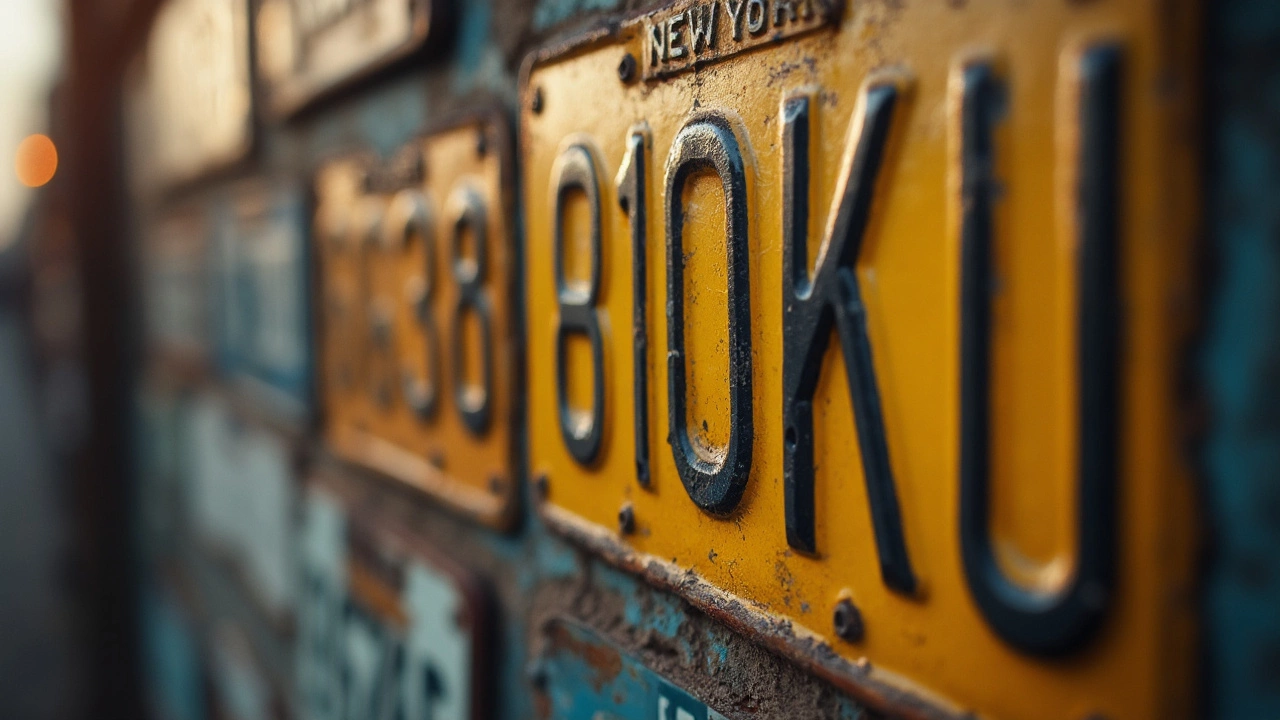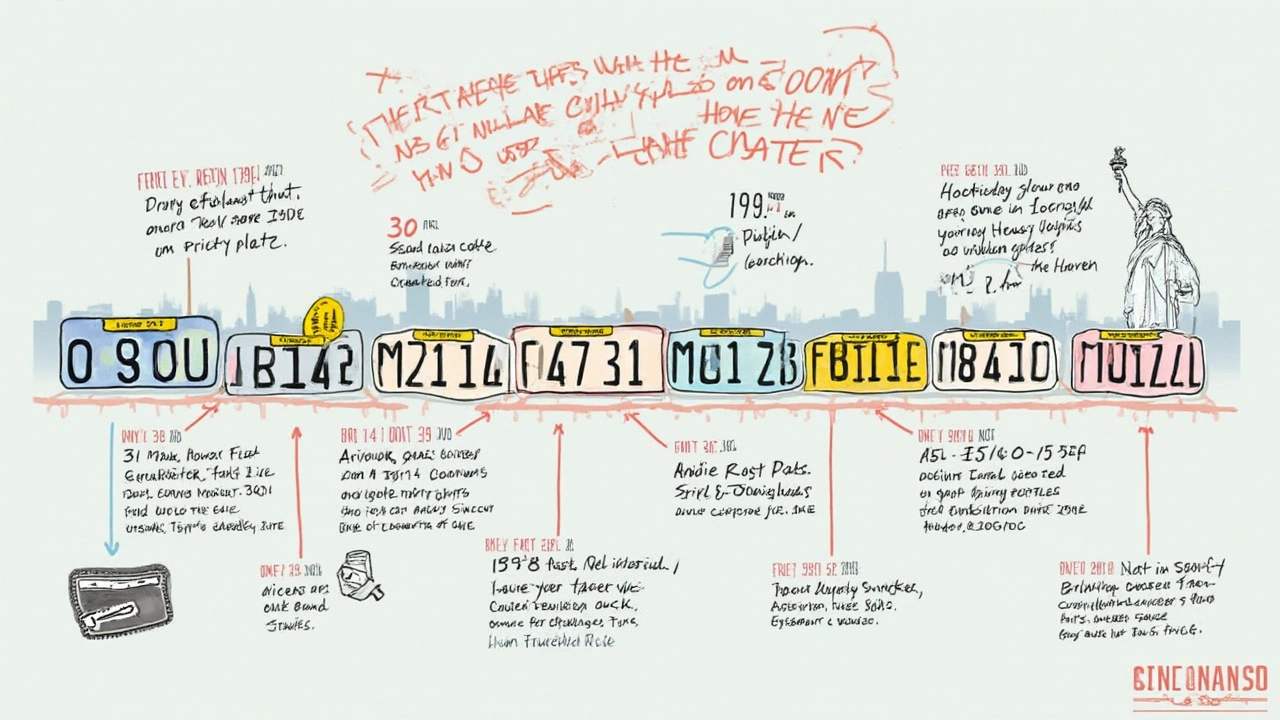Ever wondered what’s up with those bright yellow license plates on so many cars in New York? You’re not alone. It’s not just a style choice—they actually say something about how the state handles property registration and vehicle laws.
If you just moved to New York, the yellow plate might look new, but it’s been rolling out since 2010. The shift didn’t just happen overnight. And no, it’s not about some secret privilege or special status—these plates are the standard now for most vehicles. Seeing yellow on the street just means the driver is up-to-date with what the DMV is handing out.
Before you run out to check your plates or stress about switching, there’s nothing in the yellow color that changes your insurance, registration, or property rights. Yellow is just New York’s current official color for regular vehicle plates. But if you dig into the details, you’ll find out how we got here and why that actually matters for you as a car owner in the state.
- History of Yellow License Plates in New York
- Why Did New York Switch to Yellow?
- Private vs. Commercial Plates: What’s the Difference?
- What If You Still Have the Old Color Plates?
- Tips for Registering Your Vehicle and Getting Plates
History of Yellow License Plates in New York
The story of yellow license plate designs in New York isn’t just about picking a color out of a hat. Back in the 1970s and 1980s, New York was known for its reflective orange plates with blue letters. But in 2010, the state brought back a yellow look, rolling out what’s officially called the “Empire Gold” plate. This big shift replaced the old white and blue plates that had been on cars, taxis, and trucks since the late ’80s.
So why did New York turn to yellow again? Besides just standing out, officials said the new yellow license plate design would be easier to spot for law enforcement and toll cameras. Safety and readability were the top reasons. The design was also a nod back to that older orange-and-blue style, but with a modern twist—it’s got dark blue letters and a thin blue border now.
- The Empire Gold look went live for most new registrations after April 1, 2010.
- If you bought a car or renewed your plates after that date, you got the yellow plate unless you paid extra to keep your old one.
- There’s no hidden meaning behind the yellow other than its standard issue status—it’s not for VIPs or special vehicles.
Want facts? In 2012, the DMV said about 2 million Empire Gold plates were already out on vehicles statewide, and that number’s just kept growing with each passing year.
It’s pretty clear—the yellow license plate today is New York’s official look for most drivers. It marks you as current with the latest property registration system and connects you to a color scheme that plenty of New Yorkers remember from decades ago.
Why Did New York Switch to Yellow?
There's actually a good story behind New York switching to yellow license plates. Back in 2010, the state decided to roll out new plates called the “Empire Gold” design. It wasn’t just about a fresh look—New York wanted better visibility and stronger anti-counterfeiting features. Yellow just stands out more, especially in traffic and on camera, which makes things like toll collection and law enforcement easier.
The DMV also considered the classic New York blue-and-orange plates from the '70s and '80s when picking the new color. People remembered those old-school colors, so going yellow and blue felt kind of nostalgic, but still updated for modern rules. And let’s be real, it also meant a bit of extra money for the state budget. There was a fee to swap your old plates for the new yellow ones, and with millions of cars, that definitely added up.
Check out this quick breakdown:
| Year | Plate Design | Reason for Change |
|---|---|---|
| 2001 | White/Blue “Empire State” | New image, post-9/11 rebranding |
| 2010 | Yellow/Blue “Empire Gold” | Visibility, anti-counterfeiting, revenue |
So, if you see a yellow license plate in New York, it's not some rare or fancy thing. It's just the result of a statewide push for more practical, safe, and easily seen vehicle plates. The look is here to stay, at least until the DMV changes things up again.

Private vs. Commercial Plates: What’s the Difference?
If you’ve ever lined up at the DMV in New York, you’ve probably noticed more than just yellow plates—some have extra numbers or different letter combos. Here’s the deal: not all yellow plates mean the same thing. There’s a clear line between private and commercial vehicle plates, and it actually matters, especially for insurance and what you’re legally allowed to do with your ride.
Private plates are what most personal cars in New York carry. These have a standard format and are for vehicles driven for personal errands—think school runs, grocery trips, or weekend getaways. If you’re not earning money with your car, you’re likely sporting a private plate.
Now, commercial plates are a different story. You’ll see these on vans, trucks, or cars used for business—like delivering packages, hauling equipment, or if you run a rideshare full time. The state keeps a close eye on these because commercial use comes with different rules and more regulation. The DMV sums it up best:
“A commercial vehicle is defined by its use, not just its type. If you’re using a vehicle for business, you’ll probably need commercial registration.” — New York State Department of Motor Vehicles
So, what else sets them apart? Here’s a super clear comparison:
| Plate Type | Who Gets It? | Main Use | Format Example |
|---|---|---|---|
| Private | Most drivers | Personal use | ABC-1234 |
| Commercial | Business owners, contractors | Business use & hauling | 12345-BA |
Switching from private to commercial (or vice versa) means paperwork and sometimes higher fees. And if you get it wrong—say, using a private plate for steady delivery driving—you might get nailed with fines if you’re pulled over.
So to sum up: if your car is just for the basics—work commutes, family trips—your yellow license plate is private. But the second you start using it for work, you need to look into commercial plates. It’s a simple color but the rules underneath can bite you if you don’t pay attention to which plate you should actually have.
What If You Still Have the Old Color Plates?
If you’ve got the old white-and-blue New York plates on your ride, you might wonder if you’re breaking a rule or if you’re supposed to switch to the new yellow license plate right away. Here’s the straight deal: as long as your registration is current and your plate’s still in good shape (no major fading, peeling, or damage), you’re allowed to keep using those older plates. New York didn’t force everyone to swap overnight when they rolled out yellow.
The DMV mainly wants plates that are readable for law enforcement and tolling. If your old color plate checks out, you’re good. The only time you’re required to get the yellow license plate is if you:
- Register a newly purchased car
- Move to New York from another state
- Replace a damaged, lost, or illegible plate
One cool fact: As of 2025, about 18% of private vehicles on the road in New York still have the older plate designs. It’s normal to see a mix, especially since New York lets people hang onto the older style until a replacement is needed. This approach saves drivers cash and hassle.
If you want to change to the newer yellow license plate for looks or pride, you can ask for a replacement at the DMV or online. Just know there’s a fee for that, even if your old plates still work just fine. Only swap early if you want the new look or yours are falling apart. Otherwise, no rush.

Tips for Registering Your Vehicle and Getting Plates
Getting your yellow license plate in New York isn’t complicated, but a few mistakes can drag out the process or cost you extra. Here’s what you need to know to keep things smooth and quick.
- Gather what you need first. For a new registration you’ll need proof of ownership (like the title or bill of sale), a signed application (MV-82), proof of identity (typically a NY State driver’s license), insurance info, and payment for fees.
- Don’t skip inspection. If you’re registering in NY for the first time, your vehicle needs a state inspection within 10 days. Get your car inspected before or right after registration to avoid tickets.
- Go early or book an appointment. DMV lines in big NY locations can get crazy. Book online or show up early in the morning—less waiting, less stress.
- Fees and taxes are no joke. Registration, plate fees, and New York’s vehicle use tax can add up. Fees usually depend on vehicle weight but count on paying at least $25 for plates and $50–$150 for registration (first time for most cars). Sales tax is due on most purchased vehicles, even if you bought it from a friend.
- Out-of-state? Watch the timing. If you’re moving in, register your car within 30 days of becoming a New York resident, or you risk fines and a suspended registration.
Here’s a quick breakdown of the basic cost you should expect:
| Item | Typical Cost |
|---|---|
| Initial registration | $50–$150 |
| Standard yellow license plate set | $25 |
| Sales tax | Varies (average 8–9% in NY) |
| Inspection fee | $10–$27 |
If you want a custom or “vanity” plate, tack on another $60–$90 upfront, and extra per year. But for most drivers, sticking with the regular yellow license plate is the fastest and cheapest option.
Lastly, don’t forget—you can register a vehicle and get your plates in person, by mail, or for some transactions, online. But you’ll only be handed physical plates if you show up, so factor in time for mail delivery if you go that route.
